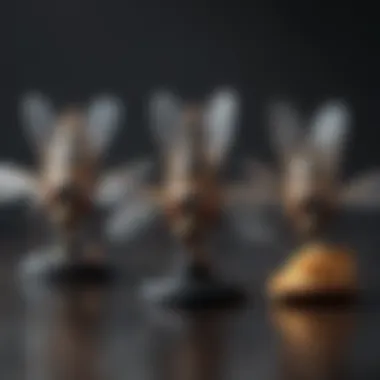The Importance of Fly Zappers in Restaurant Hygiene


Preventive Pest Control Strategies
Effective pest management doesn’t begin with reactive measures; it starts well before pests ever set foot in your establishment. A proactive approach encompasses a variety of strategies aimed at prevention, tailored specifically for restaurants where hygiene and customer safety are paramount.
House Exterior Protection
Your restaurant's exterior serves as the first line of defense against flying pests like flies and mosquitoes. To bolster this barrier:
- Tips for sealing cracks: Inspect the building’s exterior for cracks and crevices. Sealing these helps to thwart entry points where pests might sneak in. Utilize caulk or expandable foam for a tight seal.
- Clearing debris: Keep the landscaping tidy. Overgrown bushes, stacked materials, or standing water can be a buffet for pests, drawing them closer to your building.
- Preventing pests from entering: Installing screens on windows and doors or utilizing air curtains can be effective in keeping unwanted guests outside where they belong.
Yard Maintenance
A well-kept yard is not just visually appealing; it is an important aspect of pest prevention as well.
- Essential yard care routines: Regular mowing, pruning, and leaf cleanup will eliminate habitats for pests, making your restaurant less attractive.
- Methods for keeping yard pest-free: Incorporating pest-resistant plants, such as lavenders and marigolds, can naturally deter some pests.
Indoor Cleanliness
Once pests make it inside, it can create chaos. Ensuring that the interior remains spotless is crucial.
- Expert cleaning tips and techniques: Daily maintenance should include sweeping, mopping, and wiping down surfaces. Don’t forget the floors and hard-to-reach areas where crumbs can collect.
- Maintaining a pest-resistant indoor environment: Store food properly in sealed containers, and never leave food leftovers unattended to nip potential infestations in the bud.
Garbage Disposal
Waste management is a massive piece of the puzzle in pest control.
- Efficient waste disposal methods: Ensure garbage bins are sealed and emptied regularly. It's advisable to use containers made of durable materials that pests can't chew through.
- Importance of proper garbage disposal: A clean and hygienic waste area decreases the chances of attracting pests, which can adversely affect your establishment’s reputation.
Other Pest Prevention Strategies
Beyond the basic practices, integrating some creative methods can enhance your pest control approach.
- Innovative ways to safeguard your home: Consider using motion sensor lights outside to deter night predators, or even placing copper mesh over vents to keep out critters—out of sight, out of mind.
"An ounce of prevention is worth a pound of cure"—this old adage holds particularly true in pest management, where foresight can prevent the headaches down the road.
In summary, by focusing on preventive tactics in exterior protection, yard maintenance, cleanliness, garbage disposal, and innovative solutions, restaurant owners can effectively mitigate pest risks before they escalate into a bigger problem.
Foreword to Fly Zappers in Restaurants
In the bustling world of restaurants, maintaining a clean and inviting atmosphere is paramount. Customers expect delightful dining experiences that are free from uninvited guests. Here, the role of fly zappers becomes essential, not just as a pest control device, but as a crucial ally in upholding hygiene standards.
The usage of fly zappers helps to fortify restaurants against the persistent issue of flies and other pests. Beyond their mechanical efficacy, they symbolize a commitment to a healthy environment for both patrons and staff. When a restaurant employs a fly zapper, it’s making a statement: cleanliness is key. The buzzing of pests can conjure up unease among diners, and that’s an emotion no establishment can afford; thus, having an efficient fly management system is not merely advantageous but necessary.
Understanding The Need for Pest Control
Flies in restaurants are more than a nuisance; they pose significant health risks. These pests can contaminate food and surfaces, introducing pathogens that might lead to foodborne illnesses. A single fly can carry numerous bacteria, which poses a substantial risk in food handling environments. Therefore, investing in pest control measures isn’t just about comfort but about complying with health regulations.
Additionally, consistent pest problems can tarnish a restaurant's reputation. With online reviews playing a massive role in shaping public perception, even one negative mention of pests could lead to a drop in customer interest. Hence, utilizing fly zappers is not only prudent but can also be a proactive approach to safeguarding a restaurant's integrity.
Overview of Common Restaurant Pests
Pests in a restaurant setting typically include the following:
- Flies: The most notorious pests. Common species include house flies and fruit flies, both of which breed quickly and are drawn to food sources.
- Cockroaches: These are resilient and can thrive in various environments, making them a threat to food safety.
- Ants: Often scouting for food, their presence indicates potential issues within operations.
- Rodents: They are not just creepy but can bring serious health hazards due to the diseases they carry.
Understanding the types of pests businesses face allows restaurant managers to choose the right strategies for pest management. Fly zappers are particularly effective because they actively attract and eliminate flying insects, leading to a cleaner and safer dining area. Using the appropriate tools aids in cultivating an inviting space where diners can relax and enjoy their meals.
Mechanics of Fly Zappers
The mechanics behind fly zappers play a pivotal role in understanding how these devices contribute to pest management and hygiene in restaurant settings. By dissecting the functionality and types of fly zappers, one gains insights into their effectiveness and efficiency. Their operation not only targets unwanted pests but also enhances the overall dining experience by maintaining a pest-free environment.
How Fly Zappers Operate
Electrocution Mechanism
The electrocution mechanism is primarily responsible for the elimination of flying insects, making it a cornerstone feature of fly zappers. When flies approach, they are drawn to the zapper’s electrified grid. As they touch the grid, a high-voltage current swiftly dispatches them. This immediate action is crucial because it minimizes the chance of infestation and keeps pests at bay. A key characteristic of this mechanism is its speed. The quick zap leaves minimal time for pests to escape, thus influencing the overall effectiveness of pest management strategies.
However, it's important to consider the potential downsides. While this method is highly efficient, there might be instances where electrocution could pose risks—especially in environments with children or pets. So, it's essential for restaurant owners to weigh the benefits against any possible hazards.
Attractant Light Sources
Attractant light sources are the unsung heroes of fly zappers. Utilizing UV or specific wavelengths of light, these zappers draw flying insects towards them, creating a targeted trap that consistently lures pests. This intelligent design reflects a remarkable understanding of insect behavior, as certain types of flies are particularly attracted to light. For restaurants, this is a game-changer.


The unique feature of these light sources is their ability to work effectively in various settings. Even in dimly lit environments, the lights can still serve their purpose, attracting insects from afar. However, it’s worth noting that not all insects are lured by light, meaning some pests might require additional control methods alongside light-based traps.
"Incorporating the right type of attractant is crucial to maximize zapper effectiveness."
Safety Considerations
Safety considerations surrounding fly zappers are paramount, especially in environments serving food. These devices must be installed and operated with utmost caution to prevent accidental electrical shocks, fires, or any other hazards. A key aspect is the design of the zapper; newer models often incorporate safety features such as protective grids and automatic shut-off options. This means they remain safer to use, creating peace of mind for restaurant owners.
One important thing to consider is that while fly zappers are effective in controlling pests, proper maintenance and installation in accessible areas can significantly enhance safety. Thus, it becomes evident that any fly zapper integrated into a restaurant should not only be efficient but also prioritizes safety for both employees and diners.
Different Types of Fly Zappers
Electric Fly Zappers
Electric fly zappers are perhaps the most recognized type available on the market. Utilizing the electrocution mechanism we discussed earlier, these devices offer an effective solution for buzzing nuisances. The simplicity and directness of electric fly zappers make them a popular choice among restaurant owners. They operate with minimal fuss, requiring just a power source to function.
However, while electric zappers are effective, they have peculiar maintenance needs. The collection trays must be emptied regularly, and the grids require cleaning to maintain their efficiency. If neglected, these devices could become less effective over time, negating the initial investment.
UV Light Zappers
UV light zappers take advantage of ultraviolet light to attract and subsequently eliminate flies. These devices appeal to a broader range of insects than electric zappers alone. As a result, their versatility is noteworthy. They can be particularly beneficial in restaurants with outdoor seating, as they can lure pests away from patrons and food.
Nonetheless, a drawback to UV light zappers is that they may not be as effective against all pest species. Some pests may not be attracted to UV light at all, creating the potential need for more comprehensive pest management systems that blend various control methods.
Sticky Traps
Sticky traps represent a non-electric option for fly control, relying on adhesive surfaces to ensnare insects. These devices are very easy to set up and require no power, making them a convenient option for many establishments. Sticky traps appeal not only to flies but also to other crawling pests, further broadening their effectiveness.
However, their limitations include the need for regular replacements, as the sticky surface loses its efficacy over time. Moreover, depending on placement, sticky traps can become visual clutter, which might detract from the restaurant's aesthetic.
In summary, understanding the mechanics of fly zappers and their various forms is essential for enhancing pest management in restaurants. Each type of zapper has unique features and considerations that must be evaluated carefully to achieve the best results in maintaining hygiene and customer satisfaction.
Implementing Fly Zappers in a Restaurant
When it comes to maintaining a clean and pest-free environment in restaurants, implementing fly zappers can play a critical role. These devices not only help in controlling the pesky insect population but also contribute significantly to the overall hygiene standards of an establishment. The strategic installation of fly zappers is a key component in effective pest management, ensuring that the dining experience remains pleasant for patrons.
Optimal Placement Strategies
High-Frequency Areas
One of the most effective strategies for placing fly zappers is in high-frequency areas, where foot traffic is constant. These spots are often bustling with customers, making them prime locations for fly activity. By positioning zappers here, restaurants can tackle the problem before it becomes evident to diners.
The key characteristic of high-frequency areas is visibility. It's essential for the zapper to be easily spotted, raising awareness among staff and guests about pest control efforts. This visibility translates into a feeling of security for the diners, knowing that the restaurant is proactive about their health and safety.
However, these areas can pose challenges as well—regular maintenance is required to ensure that zappers are functioning effectively amid the constant movement.
Near Entrances and Exits
Placing fly zappers near entrances and exits is another strategy that proves beneficial. These locations serve as the primary entry points for flies, making them an ideal battleground. Installing zappers here creates a barrier between potential pests and the dining space, reducing the chances of insects making their way inside.
These zapper units often attract flies with their bright lights, which lure insects in from outside. The unique feature of having zappers at these entry points is their role as a first line of defense. However, it’s crucial to balance placement so they do not become an eyesore or nuisance to customers.
Outside Patios
Outside patios can present a different challenge when it comes to pest management. Here, diners are often more vulnerable to the whims of nature, including pests. Positioning fly zappers around patio spaces not only frustrates flies but also allows diners to enjoy their meals without fear of unwelcome guests.
The key characteristic of outside patios with zappers is their enhanced dining ambience. These devices can help create an inviting space by reducing the pest population significantly. Yet, the downside lies in their exposure to weather elements, necessitating more frequent checks and maintenance to ensure effectiveness.
Installation Best Practices
Professional Installation vs. DIY
When it comes to installation, restaurants often weigh the pros and cons of professional installation versus a do-it-yourself (DIY) approach. Opting for professional installation generally guarantees adherence to guidelines and expert handling of electrical components. This choice often ensures greater reliability and reduces the risks associated with improper installation.
However, some establishments may lean towards the DIY route to cut costs. While this can be an attractive option, the unique feature of professional installation is the peace of mind it brings regarding safety and efficiency.
Electrical Requirements
Understanding the electrical requirements is vital for effective operation. Fly zappers typically need a consistent power supply to function optimally. The key characteristic here involves knowing the wattage and voltage specifications needed for the device. This attention to detail not only ensures functionality but also compliance with safety standards.
In some cases, particular zappers may adapt well to low-voltage setups, which offer flexibility during installation. However, failing to meet electrical requirements can lead to ineffective operation or even device failure.
Follow Manufacturer Guidelines
Following manufacturer guidelines is paramount while implementing fly zappers in restaurants. Each device comes with its own set of instructions regarding placement, maintenance, and safety protocols. Adhering to these guidelines can optimize the performance of the zappers and extend their lifespan.


The benefit of following these guidelines lies in achieving the best results from pest control efforts. Ignoring them may result in an inefficient system that fails to provide the necessary protection against pests, compromising both hygiene and customer satisfaction.
"A restaurant that prioritizes hygiene through strategic pest management not only protects its patrons but also enhances its reputation in the community."
By understanding the optimal placement strategies and installation best practices, restaurants can effectively implement fly zappers as a crucial part of their pest management and hygiene efforts.
Effects on Restaurant Operations
Understanding the effects of fly zappers on restaurant operations is fundamental for owners and management teams, as it directly interlinks with food safety and customer satisfaction. Implementing these devices can significantly contribute to establishing a cleaner, healthier dining environment. The operational dynamics of any restaurant can be enhanced by prioritizing pest control, which ultimately plays a vital role in maintaining hygiene standards and ensuring both customer longevity and employee safety.
Pest Impact on Food Safety
The presence of pests like flies poses serious risks to food safety. Houseflies, for example, are often carriers of various pathogens. They can easily contaminate food surfaces, utensils, or even directly the dishes served to customers. According to various studies, one fly can carry hundreds of thousands of bacteria, making them a considerable health hazard.
Efficient pest management through the use of fly zappers helps mitigate these risks significantly. By systematically monitoring and trapping these pests, fly zappers effectively reduce the potential for contamination. Moreover, when customers see that a restaurant is actively taking pest control seriously by utilizing visible fly zappers, it promotes a sense of trust in the establishment's overall hygiene practices.
Regular maintenance and strategic placement of these devices can further maximize their effectiveness. Staff should be educated on identifying food safety breaches caused by pests, as this awareness supports the proactive use of fly zappers.
Customer Perception and Experience
The ambiance and cleanliness of a restaurant have a profound impact on customer perception. Diners are likely to steer clear of establishments where they perceive pest issues. An effective fly zapper setup not only combats these unwanted guests but also enhances the overall dining experience by eliminating distractions that pests cause.
Consider this: patrons don’t want to see flies buzzing around their plates or feel uneasy about the hygiene standards of the restaurant they chose for their meal. When pests are effectively controlled, customers tend to linger longer, enjoy their meals more, and even spend more on dessert or drinks.
In addition to boosting immediate customer satisfaction, utilizing fly zappers can have ripple effects on reputation. Word of mouth spreads quickly, and if customers feel confident in the cleanliness of a place, they will likely share that experience with others, enhancing the restaurant’s allure and attracting new clientele.
Ultimately, integrating fly zappers into a pest management strategy provides a twofold benefit—ensuring food safety while simultaneously elevating customer perception. This not only fosters a healthier dining environment but also helps to cultivate lasting relationships with patrons.
Economic Considerations
When managing a restaurant, understanding economic considerations is as crucial as whipping up a delicious dish. The outlay involved in pest control solutions, particularly fly zappers, plays a pivotal role in successful operations, affecting everything from initial purchases to ongoing maintenance costs. House owners and housewives alike should know that a well-planned budget can save both time and money in the long run, helping to maintain a clean and inviting space for family or guests.
Initial Investment and Operational Costs
Cost Analysis of Different Types
Fly zappers come in various types, each with its own price tag and features. For instance, electric fly zappers might have a higher upfront cost, but they tend to be more effective in trapping those pesky intruders. Their key characteristic lies in their ability to lure insects using light and then zap them, which is not only efficient but also reduces the chances of a large infestation.
When comparing the initial cost of electric zappers versus UV light zappers or sticky traps, one can see that while electric options might require a bigger initial investment, they often yield greater results.
A unique feature of these electric devices is their range. They can cover larger areas, making them a wise investment for bigger dining spaces. On the flip side, they consume electricity—this could lead to higher utility bills if not balanced with other energy-saving strategies.
Budgeting for Maintenance
Proper budgeting for ongoing maintenance is another essential aspect to consider. Regular cleaning and upkeep of fly zappers ensure they function at their best. This means setting aside funds for cleaning supplies, replacement bulbs, or any necessary repairs.
The key characteristic of budgeting for maintenance revolves around forecasting potential costs associated with each type of zapper. For example, a UV light zapper often needs bulb replacements more frequently compared to more robust electric models.
However, calculating these costs is crucial to the overall investment strategy. Adopting a proactive approach can minimize unexpected expenses.
Financially, budgeting for maintenance also helps highlight a unique advantage: it allows restaurateurs to maximize device efficiency. A well-maintained zapper attracts and traps pests better, ultimately leading to fewer pest-related losses.
Long-Term Financial Benefits
Reduction in Pest-Related Losses
A mainstay of pest management is, of course, its impact on financial health. Proper pest control, particularly through the use of fly zappers, translates into a marked decrease in pest-related losses. These losses can manifest in various ways: spoiled food, damaged reputations, and even legal fines from health inspections. By cutting down on infestations, fly zappers help in protecting revenue.
A standout feature of implementing these zappers is they create a conducive dining atmosphere. This advantage is twofold: a pest-free environment enhances customer experiences and diminishes complaints. Restaurateurs should take heart in knowing that investing in fly zappers pays off over time, as enhancing hygiene directly impacts the bottom line.
Potential Impact on Customer Retention
Customer retention speaks volumes about a restaurant's success, and maintaining a hygienic environment is integral. Guests are more likely to return if they feel safe from pests. A zapper that effectively manages fly populations can significantly enhance customer perception of cleanliness and quality.
The unique feature of this relationship is its strength—happy, returning patrons contribute to consistent revenue streams. For those who might doubt the value of upfront investment, the long-term financial benefit of customer loyalty is often beyond measure.
Using fly zappers isn’t just about protecting food; it’s about creating an ambiance that invites patrons to linger longer and return often.
"A restaurant that prioritizes cleanliness earns more than just repeat customers; it earns a place in their hearts."
By recognizing these economic considerations, restaurant owners can make informed decisions that not only shield their premises from pests but also enhance their overall business landscape.
Health and Safety Regulations
In the context of restaurants, adhering to health and safety regulations is paramount. These regulations govern how food is handled, served, and maintained, ensuring not just the safety of the patrons but also the hygiene of the establishment. Fly zappers play a crucial role in this regulatory framework, primarily by minimizing pest-related risks. A buzzing fly can be more than just an annoyance; it can carry pathogens that threaten health. Therefore, understanding and implementing necessary regulations regarding fly management is vital for operational integrity and customer trust.


Understanding Regulatory Requirements
Restaurants are often inspected by local health entities that ensure compliance with guidelines aimed at protecting public health. These regulations can vary from one jurisdiction to another but typically include sanitation protocols, pest control policies, and guidelines for maintaining overall cleanliness. Moreover, restaurants must not only have fly zappers in place but also demonstrate a commitment to their ongoing use and maintenance, which is a key expectation in regulatory audits.
Compliance with Health Code Standards
Local Health Departments
Local health departments serve as the frontline guardians of public health, be it protecting against foodborne illnesses or monitoring establishments for compliance with health codes. A key aspect of their function is evaluating pest control measures. Fly zappers, being a visible and effective means of pest management, often become a focal point during inspections. A notable characteristic of local health departments is their role in creating tailored guidelines that reflect the unique needs and environmental considerations of their community.
This aspect makes them a popular choice for restaurants aiming to maintain compliance; they provide localized insight, aligning broader health standards with regional realities. However, the unique feature of local health departments is the frequent updates to health regulations, often requiring restaurant owners to remain vigilant and adaptable. While this can feel like a burden, staying informed can ultimately benefit the operation—resulting in a clean, hygienic restaurant that builds goodwill among customers and enhances repeat business.
Documentation and Inspections
In addition to ongoing compliance with health standards, proper documentation plays a critical role in proving adherence to regulations. Documentation is not just a box to check; it serves as a record of the efforts taken in pest control and hygiene. Health inspectors rely on documented evidence during inspections to verify that fly zappers are properly maintained and that pest control strategies are being effectively executed. This transparency establishes trust and represents a restaurant's commitment to safety.
Furthermore, meticulous documentation allows restaurant owners to track any issues or patterns in pest presence, helping refine pest control strategies over time. A unique characteristic is the structured approach to inspections; they often come with checklists that simplify compliance tracking.
While the benefits of having organized documentation are clear, it can be a double-edged sword—an oversight can lead to unintended violations, resulting in possible fines or lower inspection ratings. Thus, a commitment to diligent record-keeping and regular reviews can ultimately safeguard the restaurant's reputation along with its financial viability.
Focus on maintaining robust documentation and understanding local health codes can simplify compliance and enhance operational efficacy.
In essence, the intersection of health regulations and restaurant operations underscores how crucial fly zappers are—not only for pest control but also for aligning with local health expectations, documenting compliance, and ensuring a hygienic atmosphere for diners.
Maintenance of Fly Zappers
Ensuring the consistent functionality of fly zappers is pivotal for their effectiveness in pest management within restaurant environments. Regular maintenance not only prolongs the lifespan of these devices, but it also enhances their operational efficiency. Proper upkeep can create a proactive approach to pest control. By routinely checking and maintaining fly zappers, restaurant owners can ensure that they are providing a safe and hygienic space for their patrons.
Regular Maintenance Checklist
A systematic approach to maintaining fly zappers is essential. Here are specific steps that should be a part of the maintenance protocol:
- Visual Inspection: Regularly examine the entire unit for signs of wear, damage, or corrosion. Small cracks might lead to bigger issues down the line, so catching them early is key.
- Cleaning the Grids: The electric grids can accumulate grease and dust, which reduces their efficacy. Using a damp cloth to wipe them down weekly can prevent buildup.
- Replace Bulbs: Make a point to replace UV bulbs as recommended by the manufacturer. Diminished brightness affects how many flies are attracted to the device.
- Check for Pests: Periodic observation of the catch tray is necessary to manage the fly population efficiently. It is advisable to clear it out regularly to maintain performance.
- Ensure Proper Positioning: Check the zappers’ placement to ensure they are in optimal locations. Adjust if nearby obstacles are blocking light or airflow.
Following this checklist ensures that fly zappers remain a reliable component of a restaurant’s pest management strategy.
Troubleshooting Common Issues
Sometimes, despite the best maintenance efforts, issues can still arise with fly zappers. Here are some common problems, along with solutions.
Electrical Problems
Electrical issues can often arise in fly zappers, and these glitches can significantly hamper their functionality.
- Key Characteristic: One of the primary causes for electrical problems is a faulty connection or a blown fuse. If the zapper is not powered on, checking the electrical outlet and power cord is a good starting point.
- Benefits: Addressing electrical problems swiftly enhances the reliability of the device. The faster these issues are resolved, the more pest control efficiency remains intact.
- Unique Feature: Electrical components require a bit of know-how, and this might necessitate hiring a professional technician for complex issues, something that could incur additional costs. However, knowing when to get professional help can eliminate downtime.
Maintenance Gaps
Maintenance gaps refer to the lapses in regular upkeep that can lead to diminished performance of fly zappers.
- Key Characteristic: Missing scheduled cleanings or checks can create a breeding ground for pests, undermining the zapper’s intended function.
- Benefits: Recognizing these gaps quickly allows restaurant operators to tighten their maintenance protocols, boosting the zapper's performance and pest control efficacy.
- Unique Feature: Setting reminders for routine checks can be an effective strategy for many owners. This proactive approach not only helps keep operations smooth but also enhances overall hygiene standards in a restaurant.
By understanding and implementing effective maintenance protocols, restaurant owners can significantly contribute to a safer, pest-free dining experience for their guests.
Future of Pest Control in Restaurants
In today’s fast-paced dining scene, the significance of maintaining hygiene and pest control in restaurants can’t be overstated. As eateries face mounting pressures from health inspections, customer satisfaction, and economic viability, the future of pest control emerges as a vital topic. With innovations constantly reshaping the landscape, restaurant owners need to keep their fingers on the pulse of the latest technology and practices. This section looks into innovations in fly zapping technology and how their integration with other pest management strategies can shape a cleaner, safer food environment.
Innovations in Fly Zapping Technology
Imagine a restaurant where the air is clear of pesky pests, and customers can dine without distraction. Innovations in fly zapping technology play a crucial role in that vision. Modern fly zappers have evolved significantly, shifting from the traditional bulky models to sleek devices that blend seamlessly with restaurant decor. For instance, the latest models incorporate smart sensors that not only capture insects but also monitor their activity levels. This data can be analyzed to identify peak infestation times, helping managers adjust their pest control strategies accordingly.
Another exciting advancement is the use of integrated UV light wavelengths, which are more effective at attracting a wider range of flying insects. Compared to previous technologies, these zappers are environmentally friendlier and don’t rely on chemical attractants, making them a healthier option for any food establishment. Moreover, some models now come equipped with app connectivity. Restaurant owners can receive alerts on their smartphones when the zapper needs maintenance or when insect activity spikes. This proactive approach means that pest management can be more targeted, reducing unnecessary downtime and potential health risks.
Integrating Fly Zappers with Other Pest Control Measures
While fly zappers are a key component of pest management, integrating them with other strategies is essential for comprehensive pest control in restaurants. This approach not only enhances the effectiveness of deterring unwanted guests but also contributes to long-term solutions that focus on prevention.
Biological Control Options
Biological control options offer a natural route to pest management. This method utilizes other organisms to help keep pest populations in check, such as introducing predatory insects that feast on flies. One of the standout characteristics of biological controls is their eco-friendliness. Rather than relying on chemicals, which can be harmful to both human health and the environment, these solutions harness nature’s own balance.
A unique feature of biological control is its sustainability. Instead of being a temporary fix, it can lead to long-term pest suppression. However, it has its drawbacks; restaurant owners must ensure that these introduced species do not become pests themselves. Monitoring and management are crucial to make sure the ecosystem stays balanced.
"Every restaurant should consider an integrated approach to pest control, where innovation meets nature to create a harmonious dining environment."
Cultural Practices
Cultural practices also contribute greatly to the overarching goal of effective pest management. This includes strategies like maintaining cleanliness and proper food storage, which are fundamental to thwarting infestations from the get-go. One significant characteristic of cultural practices is that they are proactive measures, often rooted in education and routine behavior adjustments.
For example, frequently disposing of food waste and regularly cleaning surfaces can significantly reduce pest attraction. A unique aspect of cultural practices is their voluntary nature—once proper habits are established, team members can ensure a hygienic environment consistently. However, this method does require commitment from all staff, and if adherence to these practices wanes, problems can arise. Hence, training and ongoing reminders are essential.



